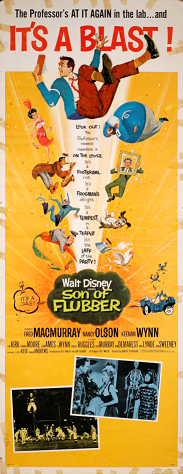Transforming the museum's Theater Lobby into a tribute to one of the past, we have a new showcase on display that features a brief history—and unique collection—of original live action movie posters, lobby cards and promotional collateral from Disney classics such as Mary Poppins, Swiss Family Robinson, Old Yeller, Davy Crockett and many more. This exhibit is free with paid Museum admission, and can be viewed Wednesday through Sunday, 10am–6pm, on the Lower Level of The Walt Disney Family Museum. Here's a little taste of what it's all about:

"We won't turn into a live-action studio, but we'll get into the live-action business." —Walt Disney
Disney’s UK Funds After World War II
The end of World War II presented a new creative opportunity for Walt. Like most war-damaged countries, Britain had frozen payments due to American film companies. Disney and RKO had millions of dollars that could only be spent in the United Kingdom. Walt decided to use these funds in England and started work on his first live action film: An adaptation of Robert Louis Stevenson's Treasure Island. The cast and crew were all from the UK, with the exception of the director, producer and the movie's child star Bobby Driscoll.

The Start of Live Action Films
Treasure Island was released in July 1950, and was the first of 59 full-length, live action films Walt produced between 1950 and 1966. Additionally, five more films would be credited to Walt through the end of 1967. Actors such as Sean Connery, Kurt Russell, Julie Andrews, Kirk Douglas, Hayley Mills, Dick Van Dyke, Dean Jones, Fred MacMurray and Annette Funicello played a part in one or more of the films during this productive period. And in 1964, Julie Andrews won an Oscar for her role as the delightful nanny, Mary Poppins.
Walt was excited by the possibilities of live action films and the incredible stories he could tell using this medium. When Walt returned from making films in England, one animator remarked, "We realized that as soon as Walt rode on a camera crane, we were going to lose him."
The Evolution of Movie Posters
Though the content and style of movie posters have changed dramatically since the late 1800s, their purpose has remained the same: to attract the attention of the public so their curiosity is aroused and they reach for their wallets at the box office. In the 1960s when films such as The Misadventures of Merlin Jones premiered, theater owners could choose from a variety of poster sizes and types to promote the film. And unlike film posters today, which typically feature striking photographs of the main actors, posters produced prior to the 1990s showcased colorful illustrations. These types of posters created what would eventually become iconic vintage Disney posters.
Historically, the most popular poster size—and virtually the only size used today by exhibitors in the United States—was the One-Sheet measuring 41 x 27 inches. Also appealing to theater owners was the Half-Sheet, a movie poster with a horizontal orientation of 22 x 28 inches, a size more easily displayed in a small room. Inserts (sometimes called "door panels") were posters having a vertical format measuring 36 x 14 inches, making it possible for them to be used in narrow spaces where other posters could not fit.
Smaller sized movie posters included Window Cards, designed chiefly for off-site advertising and often seen in the windows of local businesses. Measuring 14 x 22 inches, these posters featured a blank area of approximately five inches at the top of the sheet where an exhibitor could include the theater locations and play dates of a film. The smallest of the early movie posters was the Lobby Card, generally printed in a set of eight different cards, with one set consisting of a title card, along with several scene cards.
These posters marked the beginning of Disney’s live action films, and have now become vintage Disney posters that fans love to look at and see how far Disney films have come.
Visit Us and Learn More About Disney’s Amazing History
Originally constructed in 1897 as an Army barracks, our iconic building transformed into The Walt Disney Family Museum more than a century later, and today houses some of the most interesting and fun museum exhibitions in the US. Explore the life story of the man behind the brand—Walt Disney. You’ll love the iconic Golden Gate Bridge views and our interactive exhibitions here in San Francisco. You can learn more about visiting us here.

Anel Muller
Registrar and Curatorial Assistant
